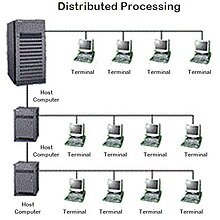Computer Network
Computer network
"Computer networks" redirects here. For the periodical, see Computer Networks (journal).
"Datacom" redirects here. For other uses, see Datacom (disambiguation).
A computer network is a telecommunications network that allows computers to exchange data. The physical connection between networked computing devices is established using either cable media or wireless media. The best-known computer network is theInternet.Network devices that originate, route and terminate the data are called network nodes.[1] Nodes can include hosts such as servers andpersonal computers, as well as networking hardware. Two devices are said to be networked when a process in one device is able to exchange information with a process in another device.
Computer networks support applications such as access to the World Wide Web, shared use of application and storage servers,printers, and fax machines, and use of email and instant messaging applications. The remainder of this article discusses local area network technologies and classifies them according to the following characteristics: the physical media used to transmit signals, thecommunications protocols used to organize network traffic, along with the network's size, its topology and its organizational intent.
Properties
Computer networking may be considered a branch of electrical engineering, telecommunications, computer science, information technology or computer engineering, since it relies upon the theoretical and practical application of the related disciplines.A computer network has the following properties:
- Facilitates interpersonal communications
- People can communicate efficiently and easily via email, instant messaging, chat rooms, telephone, video telephone calls, and video conferencing.
- Allows sharing of files, data, and other types of information
- Authorized users may access information stored on other computers on the network. Providing access to information on shared storage devices is an important feature of many networks.
- Allows sharing of network and computing resources
- Users may access and use resources provided by devices on the network, such as printing a document on a shared network printer. Distributed computing uses computing resources across a network to accomplish tasks.
- May be insecure
- A computer network may be used by computer Hackers to deploy computer viruses or computer worms on devices connected to the network, or to prevent these devices from accessing the network (denial of service).
- May interfere with other technologies
- Power line communication strongly disturbs certain forms of radio communication, e.g., amateur radio. It may also interfere withlast mile access technologies such as ADSL and VDSL.
- May be difficult to set up
- A complex computer network may be difficult to set up. It may be costly to set up an effective computer network in a large organization.

ไม่มีความคิดเห็น:
แสดงความคิดเห็น